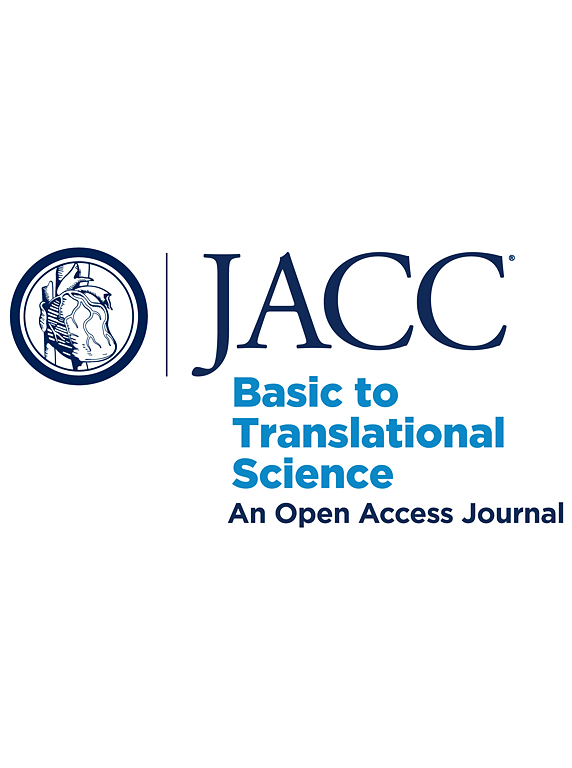Integrated Systems Biology Identifies Disruptions in Mitochondrial Function and Metabolism as Key Contributors to HFpEF
IF 8.4
1区 医学
Q1 CARDIAC & CARDIOVASCULAR SYSTEMS
引用次数: 0
Abstract
Heart failure with preserved ejection fraction (HFpEF) accounts for ∼50% of HF cases. The ZSF1-obese rat model recapitulates clinical features of HFpEF including hypertension, obesity, metabolic syndrome, exercise intolerance, and diastolic dysfunction. We utilized a systems-biology approach to define the metabolic and transcriptional signatures to gain mechanistic insight into pathways contributing to HFpEF development. Male ZSF1-obese, ZSF1-lean hypertensive controls, and WKY (wild-type) controls were compared at 14 weeks of age for extensive physiological phenotyping and left ventricle (LV) tissue harvesting for unbiased-metabolomics, RNA-sequencing, and mitochondrial morphology and function. Utilizing ZSF1-lean and WKY controls enabled a distinction between hypertension-driven molecular changes driving HFpEF pathology, versus hypertension + metabolic syndrome. Comparison of ZSF1-lean vs WKY (ie, hypertension-exclusive effects) revealed metabolic remodeling suggesting increased aerobic glycolysis, decreased β-oxidation, and dysregulated purine and pyrimidine metabolism with few transcriptional changes. ZSF1-obese rats displayed worsened metabolic remodeling and robust transcriptional remodeling highlighted by upregulation of inflammatory genes and downregulation of the mitochondrial structure/function and metabolic processes. Integrated network analysis of metabolomic and RNAseq datasets revealed downregulation of most catabolic energy producing pathways, manifesting in a marked decrease in the energetic state (ie, reduced ATP/ADP, PCr/ATP). Cardiomyocyte ultrastructure analysis revealed decreased mitochondrial area, size, and cristae density, as well as increased lipid droplet content in HFpEF hearts. Impaired mitochondrial function was demonstrated by decreased substrate-mediated respiration and dysregulated calcium handling. Collectively, the integrated omics approach applied here provides a framework to uncover novel genes, metabolites, and pathways underlying HFpEF, with an emphasis on mitochondrial energy metabolism as a potential interventional target.
综合系统生物学鉴定线粒体功能和代谢中断是HFpEF的关键因素
保留射血分数(HFpEF)的心力衰竭占HF病例的50%。zsf1肥胖大鼠模型概括了HFpEF的临床特征,包括高血压、肥胖、代谢综合征、运动不耐受和舒张功能障碍。我们利用系统生物学方法来定义代谢和转录特征,以获得对促进HFpEF发展的途径的机制见解。在14周龄时,对雄性zsf1 -肥胖、zsf1 -瘦高血压对照组和WKY(野生型)对照组进行了广泛的生理表型分析和左心室(LV)组织收集,以进行无偏倚代谢组学、rna测序和线粒体形态和功能的比较。利用ZSF1-lean和WKY对照可以区分高血压驱动的分子变化驱动的HFpEF病理与高血压+代谢综合征。比较ZSF1-lean和WKY(即高血压专属效应)发现代谢重塑表明有氧糖酵解增加,β-氧化减少,嘌呤和嘧啶代谢失调,转录变化很少。zsf1肥胖大鼠表现出代谢重塑恶化和强劲的转录重塑,突出表现为炎症基因上调和线粒体结构/功能和代谢过程下调。代谢组学和RNAseq数据集的综合网络分析显示,大多数分解代谢能量产生途径下调,表现为能量状态显著降低(即ATP/ADP、PCr/ATP降低)。心肌细胞超微结构分析显示HFpEF心脏线粒体面积、大小和嵴密度减少,脂滴含量增加。线粒体功能受损表现为底物介导的呼吸减少和钙处理失调。总的来说,本文应用的集成组学方法提供了一个框架,揭示了HFpEF背后的新基因、代谢物和途径,重点是线粒体能量代谢作为潜在的干预靶点。
本文章由计算机程序翻译,如有差异,请以英文原文为准。
求助全文
约1分钟内获得全文
求助全文
来源期刊

JACC: Basic to Translational Science
CARDIAC & CARDIOVASCULAR SYSTEMS-
CiteScore
14.20
自引率
1.00%
发文量
161
审稿时长
16 weeks
期刊介绍:
JACC: Basic to Translational Science is an open access journal that is part of the renowned Journal of the American College of Cardiology (JACC). It focuses on advancing the field of Translational Cardiovascular Medicine and aims to accelerate the translation of new scientific discoveries into therapies that improve outcomes for patients with or at risk for Cardiovascular Disease. The journal covers thematic areas such as pre-clinical research, clinical trials, personalized medicine, novel drugs, devices, and biologics, proteomics, genomics, and metabolomics, as well as early phase clinical trial methodology.
 求助内容:
求助内容: 应助结果提醒方式:
应助结果提醒方式:


